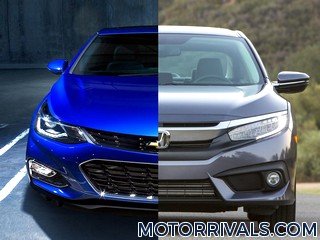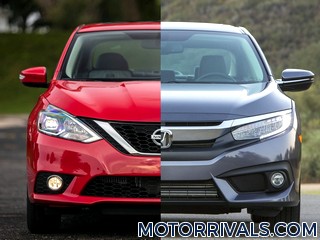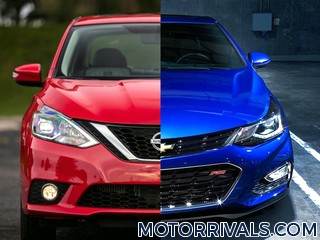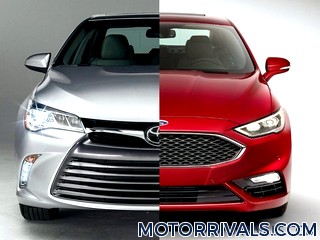2017 Mazda 3 vs 2017 Chevrolet Cruze
Mazda Press Release Highlights
Building on its award-winning predecessor, developers of the all-new Mazda 3 set out to do no less than come up with a car that actually interacts with its owner on several levels. On the surface, it's a top quality means of transport, delivering an unmatched combination of performance, fuel efficiency and functionality in a package that's as safe and practical as it is stunning. Here it follows in the footprints of its new generation forerunners: the Mazda CX-5, a compact SUV that drives like a car, and the new Mazda 6, which more recently took the mid-sized class by storm.
Powertrain
The new Mazda 3 also comes with the SKYACTIV-G 2.0 in two versions. The high-power version churns out 121kW / 165PS at 6,000rpm and 210Nm at 4,000rpm. It thrusts the compact from a standstill to 100km/h in 8.2 seconds with a terminal speed of 210km/h. At 5.8l/100km and 135g/km, fuel consumption and CO2 emissions are very respectable for such performance. The standard power SKYACTIV-G 2.0, meanwhile, puts out 88kW / 120PS at 6,000rpm and, like its sibling, 210Nm at 4,000rpm. Available for both body styles with either the SKYACTIV-Drive automatic or SKYACTIV-MT manual transmission, this economical option combines first-rate fuel efficiency and CO2 emissions - 5.1l/100 km and 119g/km (manual) and 5.6l/100 km and 128g/km (automatic) - with respective sprint times of 8.8 and 10.3 seconds, topping out at 198km/h.The SKYACTIV-D clean diesel also uses extreme compression and lightweight design as the basis for powerful yet remarkably fuel-efficient engines. Unusually for a diesel, the 380Nm of maximum torque at 1,800rpm and 110kW / 150PS at 4,500rpm offers satisfying pull from a standstill through to its 5,500rpm redline. The new Mazda 3 takes only 8.0 seconds to reach 100km/h with a manual and 9.7 seconds for the automatic (hatchback only), with respective top speeds of 213km/h and 201km/h. And that with fuel economy and CO2 emissions of 3.9l/100km and 104g/km (sedan with manual), and 4.8l/100 km and 127g/km (hatchback with automatic).
Chassis
Mazda tuned the new Mazda 3's SKYACTIV-Chassis to respond more faithfully than ever to driver intentions. High-tensile steel (780MPa) was used for the lower suspension arms on the front MacPherson struts and rear multi-link trailing arms. This not only makes the suspension lighter, but also smoothens load transfers and with it changes in cornering g-forces. The positioning of rear suspension links and hardness of the bushings, meanwhile, improves the lateral grip of the rear tires. By moving the trailing arm position forward, the dampers can better absorb road influences.The electric power assist steering's lower gear ratio - 14:1 versus 16.2:1 on the current model - means less steering wheel movement, enhancing agility and helping avoid driver fatigue, particularly on winding roads and in the city. The system is smaller, lighter and more energy efficient, too. The brakes get smaller cylinders, retuned boosters and reduced pedal play to suppress motion resistance. These improve brake control, responsiveness and fuel economy. In combination with new high-grip tires, they're particularly effective on wet roads: Stopping distances are considerably shorter than the current model and among the best in the segment.
Technology
The in-vehicle system expands on features already available in Mazdas, like Bluetooth®, email, SMS and navigation, adding a whole new scale of connected convenience. Using a smartphone connected to the Mazda 3 system via Bluetooth® or USB, Mazda 3 occupants have safe and easy real-time access via the 7-inch display to infotainment services from Aha. It offers a wide and growing range of mobile infotainment content and social media services, including tens of thousands of internet radio stations, Twitter and Facebook feeds, news, audio books and more.Aha is a cloud-based automotive grade internet connectivity platform. Available for the first time at Mazda with the all-new Mazda 3, Aha is designed to provide a single integration point bringing a wide range of free web-based infotainment content safely into the vehicle. Aha lets the user access and organize their favorite web content on their phone, then seamlessly integrates the experience in their car. Developed together with BOSE® especially for the new Mazda 3, the new 9-speaker BOSE® premium sound system features the latest in playback technology and, of course, plenty of power.
Safety
i-ACTIVSENSE is Mazda's term for its advanced range of sensor-based and radar-supported safety technology. The radar-based Rear Vehicle Monitoring system (RVM), for example, tells the driver when vehicles are approaching the new Mazda 3 from behind in adjacent lanes - including the blind spots - by activating an LED in the corresponding side mirror. The Lane Departure Warning System (LDWS), meanwhile, watches the lane markings at 65km/h and higher, alerting the driver with audible (rumble strip sound) and visual warnings should it detect unplanned lane changes. And the Distance Recognition Support System (DRSS) looks well ahead of the car, calculating and displaying the proximity and catch-up time to preceding vehicles at 30-200km/h. The Adaptive Front-lighting System (AFS) predicts the shape of the curve ahead based on steering input and speed, turning the headlamps in the right direction. Hill Launch Assist (HLA) is another helpful system that maintains brake pressure to prevent rolling during hill starts. i-ACTIVSENSE pre-crash safety technology warn the driver of potential danger. However, as names like Mazda Radar Cruise Control (MRCC) and Smart Brake Support (SBS) suggest, they'll also take evasive action if necessary to avoid an accident or limit the damage. Naturally, the new Mazda 3 also has standard ABS with electronic brakeforce distribution (EBD) and brake assist (EBA) as well as dynamic stability control (DSC) and traction control (TCS).Nissan Press Release Highlights
Powertrain
• All-new, standard 1.4L turbocharged engine - 153 horsepower (113 kW) and 177 lb-ft of torque (240 Nm)• Standard six-speed manual or a six-speed automatic transmission.
• GM-estimated 40 mpg on the highway with automatic transmission.
• Stop/start technology - automatically shuts down the engine when the car comes to a stop under certain driving conditions, such as a stoplight. The engine automatically restarts when the driver takes his or her foot off the brake.
• Expected 0-60 mph: 8 seconds
• Maximum highway range of 530 miles per tank
• In 2017, a new diesel model will be introduced
Chassis
• 0.29 coefficient of drag• 2.7 inches (68 mm) longer and nearly an inch (25 mm) shorter in height than the current model
• All-new, stronger and lighter body structure - approximately 250-pound (113 kg) lower curb weight than the current model
• MacPherson strut front suspension design with specially tuned bushings and geometry
• Torsion beam rear axle on L, LS and LT models
• Enhanced Z-link design on Premier
• Rack-mounted electric power steering is standard on all models
• Four-wheel disc brakes with Duralife longer-life rotors are standard on all models
• StabiliTrak electronic stability control, with traction control, rollover mitigation and anti-lock brakes, is standard
• Wheel sizes ranging from 15 to 18 inches.
• Class-leading 106.3-inch (2,700 mm) wheelbase enhances roominess, contributing to greater rear-seat legroom and more rear knee room
Technology
• Chevrolet MyLink with smartphone integration capability - provides simple and intuitive use of smartphones in the vehicle. It integrates certain phone functions onto the Cruze's seven-inch-diagonal color touchscreen, allowing them to call up music, navigation apps and more. An uplevel MyLink radio with an eight-inch display and navigation is available and also incorporates Apple CarPlay.• Standard seven-inch-diagonal screen and available eight-inch-diagonal screen
• Eight-inch screen only with Apple CarPlay, Android Auto coming later
• Rearview camera
• Available features - wireless phone charging, heated rear leather seats and heated, leather-wrapped steering wheel
• 4.2-inch-diagonal high-resolution driver information center in the gauge cluster
• Premium features including heated front cloth seats, heated rear leather-trimmed seats, and heated and leather-wrapped steering wheel.
• Android Auto is built around Google Maps, Google Now and the ability to talk to Google, as well as a growing audio and messaging app ecosystem that includes WhatsApp, Skype, Google Play Music, Spotify and podcast players.
• Available OnStar with 4G LTE and built-in Wi-Fi hotspot
Safety
• New, stronger body structure - incorporates high-strength steel• 10 standard air bags, including frontal driver and passenger air bags, roof rail-mounted head curtain side air bags that help protect the front and outboard rear seating positions; seat-mounted side-impact air bags (front and rear); and front knee air bags
• Available safety features include an expanded range of crash-avoidance technologies, including Side Blind Zone Alert, Rear Cross-Traffic Alert, Lane Keep Assist and Forward Collision Alert.
• Front passenger seat occupant sensing system and rollover sensing and protection system
• Collapsible pedal assembly to help protect against lower-extremity injuries
• Three-point safety belts in all five seating positions, safety belt retractor pretensioners and lap pretensioners in the driver and front-passenger positions, and safety belt load limiters (with pretensioners) in the front safety belt retractors
• LATCH child seat latching system in the rear seat
• Tire pressure monitoring system
• Daytime running lamps
• Automatic headlamps.


















